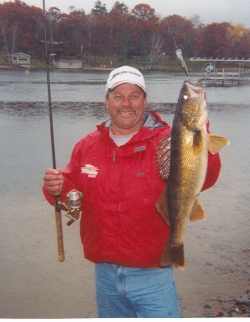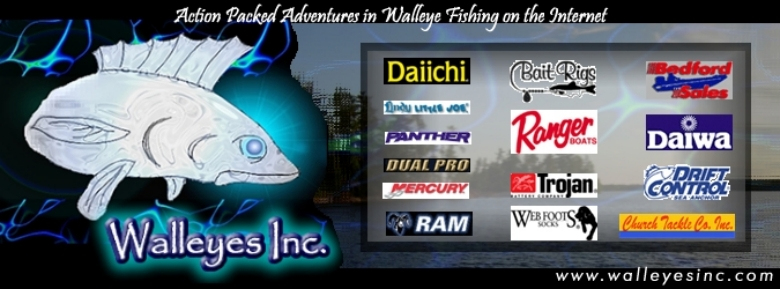| Editor's note: John Kolinski is the 2002 Professional Walleye
Trail Angler of the Year, last year's Illinois River RCL winner
and a 15-time championship qualifier on the PWT, RCL and Masters
Walleye Circuit. His articles can be read in numerous Midwestern
outdoor publications and at several web sites. Kolinski is sponsored
by Triton Boats, Mercury Motors, Lowrance Electronics, Normark/Storm
Lures, MinnKota, Lindy Legendary Tackle, Tempress Rod Holders,
Off-Shore Planer Boards, Berkley Trilene, Optima Batteries,
Panther Marine and Headlight Lures |
Big water can be overwhelming during much of
the walleye season.
Unless an angler has the luxury of fishing on an almost-daily
basis, it's tough to keep up with a species that often travels
miles in a day across largely unremarkable water in the middle
of nowhere to pursue baitfish like smelt, alewives and shad.
October changes all of that. Those thousands of acres of potentially
productive water aren't so big and bad anymore as walleyes begin
a predictable migration that takes them into areas and onto
structure that is far more accessible to anglers.
It's a time of year when everything comes together in an angler's
favor. From the Great Lakes to giant reservoirs like Fort Peck
and Sakakawea to sprawling natural bodies of water like Lake
of the Woods, tremendous numbers of walleyes head to relatively
small areas.
As always, they are motivated by food. That's what lures summer
walleyes, especially mature fish in search of larger forage,
into open water. In this case, that's what brings them back
to shallower haunts and specific structure in October and November
as they put on the feedbag to build reserves for the cold-water
months ahead.
Aquatic life comes full circle in October. Baitfish move back
to shallower water where the temperatures are slightly warmer
and they can find sustenance while preparing for their annual
spawning runs. Gamefish follow for the same reasons.
It's like a family reunion. Whether the participants like one
another or not, they'll come for the picnic. Big, small, young
or old -- they'll all be there. And you can bet the ones who
have been around the block won't be far from the table with
the brats, burgers, sweet corn and watermelon.
Most of the time, that figurative table is the breaklines that
exist in the bays and along the shorelines of these big bodies
of water. Two elements must be present -- an area to feed such
as a shallow flat or weedbed and deep water.
Find a breakline in an area that offers those characteristics
and chances are there will be good numbers of fat and sassy
walleyes present. Because the water is typically clearest in
the fall and the subsequent light penetration greatest, it makes
sense that walleyes will seek out the security and comfort of
breaklines that go down 20 feet or more.
 |
In reservoirs and large natural lakes, big main-lake
points are a good place to start, although secondary points
shouldn't be overlooked either. These are areas where
walleyes will concentrate, but it also pays to consider
how they got there. Usually, it's by following a long
and distinct breakline, and there are often plenty of
transition fish to be caught along these areas, too. In
some large lakes, the fall migration will lead walleyes
toward rivers and creeks where there are autumn runs of
shiners or other baitfish species. Focus your efforts
on the first major breaklines outside the river or creek
mouth, unless the flowage is large. In that case, check
out the river, too. The breaks provided by changes in
current can concentrate good numbers of walleyes |
In the Great Lakes, you may have to expand your search. While
breaklines at the mouths of rivers and creeks can be good, there
is usually some type of structure that ultimately attracts and
holds these walleyes, like islands or shallow-water reefs and
the breaklines around them. In other situations where these
conditions don't exist, probe the breaklines leading into bays
that feature plenty of shallow, vegetated water.
While focusing on distinct breaklines helps eliminate a lot
of water, those drop-offs can still extend for miles. That's
where a quality sonar unit can make a huge difference. I like
to motor along those breaks while paying close attention to
my Lowrance 111 HD. When I pass over baitfish or gamefish, I
mark a waypoint and continue on. Usually, I can identify three
or four specific stretches that seem to be holding most of the
fish.
Catching them isn't all that difficult. One might assume that
because there is so much forage available that it would become
harder to coax a walleye to bite. What actually happens is that
there is so much more competition for food and so many more
walleyes in the area that there are almost always some that
can be caught. Because these fish are trying to fatten up, their
periods of feeding activity are also more frequent.
If the fish seem to be grouped in small pods and scattered along
the break, I crank up my Mercury 9.9 kicker and set up a trolling
spread that features large, No. 11 and No. 13 Rapala stickbaits
or big Storm Thundersticks. I try to cover as much of the break
as possible by using a combination of Off-Shore planer boards,
deep-diving cranks on Yo-Zuri line, stickbaits with in-line
keel weights or Off-Shore snap weights or even lead-core line.
I also keep some live bait on hand. If I troll through an area
and catch a fish or two but know there are more present, I'll
slow down and offer the fish a redtail chub or large shiner.
I've even scored at times with these fish using spinner and
crawler combinations.
Basically, however, the most productive way to target these
fish is to try to pick off the most active ones and not spend
a lot of time fussing with those that already have a full belly.
October anglers have another ace up their sleeve they can play,
as well.
While the bite is generally decent all day long, there are times
when conditions make walleyes a bit finicky during daylight
hours. Fortunately, you can almost always count of them to bite
around dusk or even after dark and again around sunrise. The
same baits and techniques work, but you'll have to work more
of the shallow water than you would during the day.
As always when fishing during autumn months, dress accordingly,
watch the weather and play it safe. Be prepared for the worst-case
scenario and try not to venture too far from a ramp.
By and large, it's a great time of year to fish, and the angler
who understands the walleye's annual life cycle and migration
can get in on some of the best fishing of the season.
Break it down, size it up and get after it. It's hard not to
fall for big-water October walleyes.
|
|
Please Check Out these links
below to our site Sponsors
|
|

